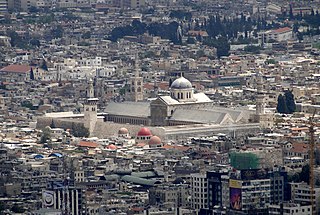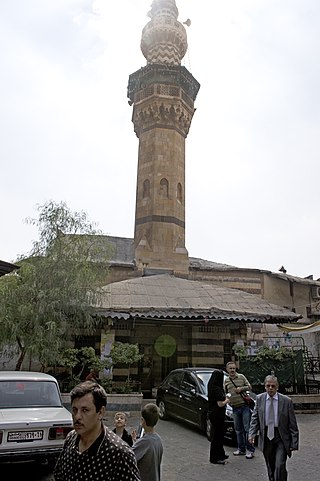
Damascus is the capital of Syria, the oldest capital in the world according to some. Known colloquially in Syria as aš-Šām (الشَّام) and dubbed, poetically, the "City of Jasmine", Damascus is a major cultural center of the Levant and the Arab world.

The Umayyad Mosque, also known as the Great Mosque of Damascus, located in the old city of Damascus, the capital of Syria, is one of the largest and oldest mosques in the world. Its religious importance stems from the eschatological reports concerning the mosque, and historic events associated with it. Christian and Muslim tradition alike consider it the burial place of John the Baptist's head, a tradition originating in the 6th century. Muslim tradition holds that the mosque will be the place Jesus will return before the End of Days. Two shrines inside the premises commemorate the Islamic prophet Muhammad's grandson Husayn ibn Ali, whose martyrdom is frequently compared to that of John the Baptist and Jesus.

Rukneddine, Rukn ad-Din or Rukn al-Din is a municipality of Damascus, Syria. In the CBS 2004 census, it had a population of 92,646. It is the historic Kurdish quarter of the city.

Al-Azm Palace is a palace in Damascus, Syria, built in 1749. Located north of Al-Buzuriyah Souq in the Ancient City of Damascus, the palace was built in 1749 to be the private residence for As'ad Pasha al-Azm, the governor of Damascus; during the French Mandate for Syria and the Lebanon, it housed the French Institute.
Qatana is a city in southern Syria, administratively part of the Qatana District of Rif Dimashq Governorate. Qatana has an altitude of 879 meters. According to the Syria Central Bureau of Statistics, the city had a population of 33,996 in the 2004 census. It is the administrative center of the Qatana Subdistrict, which contained 20 localities with a collective population of 147,451 in 2004.
Beit al-Mamlouka is a luxury boutique hotel located in the old city of Damascus, Syria. It was established in 2005 in the city's oldest borough, the Christian quarter of Bab Touma.

The Khalid ibn al-Walid Mosque is a mosque in Homs, Syria, located in a park along Hama Street in ash-Shuhada Square. The mosque is dedicated to Khalid ibn al-Walid, an Arab military commander who led the Muslim conquest of Syria in the 7th century following the decisive Battle of Yarmouk, which put an end to Byzantine rule in Syria. His dome-topped mausoleum is located in a corner of the prayer hall and has served as a pilgrimage center. Two tall minarets with narrow galleries constructed of alternating horizontal rows of white and black stone are situated at the building's northwestern and northeastern comers and reflect the traditional Islamic architecture style of the Levant.

The old city of Damascus is the historic city centre of Damascus, Syria. The old city, which is one of the oldest continuously inhabited cities in the world, contains numerous archaeological sites, including some historical churches and mosques. Many cultures have left their mark, especially Hellenistic, Roman, Byzantine and Islamic. In 1979, the historical center of the city, surrounded by walls of Roman era, was declared a World Heritage Site by UNESCO. In June 2013, UNESCO included all Syrian sites on the list of World Heritage in Danger to warn of the risks to which they are exposed because of the Syrian Civil War.

Al-Shaghour is a municipality and a neighborhood located in the old walled city of Damascus, Syria, south and east of the Old City, and east of al-Midan. Al-Shaghour is one of the oldest recorded neighborhoods in the city. The traditional neighborhood is divided into the part located within the Old City walls, known as Shaghour al-Juwani, and the much larger part located outside the walls. The latter part has become a municipality known as al-Shaghour.

Al-Midan is a neighbourhood and municipality in Damascus, Syria, south of the old walled city and near the modern city centre. In the 2004 census, it had a population of 177,456. Today, the neighbourhood is often considered to be one of the most conservative in Damascus.

The Murad Pasha Mosque is an early Ottoman-era mosque and mausoleum in Damascus, Syria, located in the Suwayqa sector of the Al-Midan quarter. The mosque was erected and named after Murad Pasha, who served as the Ottoman governor ("wali") of Damascus between 1568-1569. The mosque was built in 1568. The mosque is also known as the Naqshbandi Mosque after the Naqshbandi sufi order which it served as a center for.

Sha'alan is a neighborhood of Damascus, Syria.

Qaboun is a municipality and neighbourhood in Damascus, Syria, located 6 kilometers (3.7 mi) north-east of the city center, to the north of Jobar district.

Qanawat is a municipality of the Damascus, Syria, due west of the Old City. In the 2004 census, it had a population of 58,053. The municipality contains numerous government buildings such as the University of Damascus, National Museum of Damascus, Damascus Governorate Police headquarters, and the Ministries of Tourism, Information, and Interior. It also features historical places of interest such as the Hejaz Railway, the Sulaymaniyya Takiyya, and Hammam al-Jadid.

Presidential Palace is the residence for the President of Syria, located in Damascus. It is located in the west of the city, on Mount Mezzeh, north of Mezzeh neighborhood, next to Mount Qasioun and overlooks the city. The main building covers 31,500 square metres. The entire plateau of Mount Mezzeh is part of the palace premises and is surrounded by a security wall and guard watchtowers. In front of the building is a large fountain and the palace itself largely consists of empty rooms clad in Carrara marble.
Al-Qassaa is a neighborhood and district of the Sarouja municipality in Damascus, Syria. Qassaa is situated in the northeastern part of the city and borders the Old City neighborhood of Bab Tuma. It had a population of 11,467 in the 2004 census. Al-Qassaa's inhabitants are predominantly upper class Christians.
Masjid Aqsab, also called Masjid al-Qasab, is a neighborhood and district of the Sarouja municipality of Damascus, Syria. It had a population of 14,148 in the 2004 census. The neighborhood was founded during the Mamluk era as a suburb of the walled city of Damascus, bordering the Bab al-Salam gate to the south and contiguous with the al-Faradis neighborhood to the west. It was built around the Aqsab Mosque, after which the neighborhood was named. The mosque purportedly contained the graves of seven Sahaba. In the 1936 French Mandate census, the neighborhood had a population of 6,900, all Muslims.

Al-Qaymariyya is a quarter of the Old City of Damascus. It is located in the center of the Old City, bordering the eastern wall of the Umayyad Mosque. It had a population of 4,034 in the 2004 census.
The Khadra Palace, known in Arabic as Qubbat al-Khadra, was a residence of the Umayyad caliphs in Damascus. It was founded by the first Umayyad caliph, Mu'awiya I, while he was governor of Syria under Caliph Uthman. The Khadra Palace consisted of a series of interconnected buildings, including the caliphal residence, stables, mint and prison, situated directly behind the Umayyad Mosque. Little information is available describing the structure, other than the green color of its dome, its construction from baked brick, timber and marble pavement and its setting amid gardens.

The Salimiyya Takiyya is a takiyya in as-Salihiyya, Damascus.














